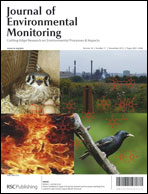Journal of Environmental Monitoring 14(11)
Overview of articles on POPs in a new issue of the Environment International journal.

Roland Kallenborn, Crispin Halsall, Maud Dellong and Pernilla Carlsson
p. 2854-2869
- The effect of climate change on the global distribution and fate of persistent organic pollutants (POPs) is of growing interest to both scientists and policy makers alike. The impact of warmer temperatures and the resulting changes to earth system processes on chemical fate are, however, unclear, although there are a growing number of studies that are beginning to examine these impacts and changes in a quantitative way. In this review, we examine broad areas where changes are occurring or are likely to occur with regard to the environmental cycling and fate of chemical contaminants.
Da Chen, Robert J. Letcher and Pamela Martin
p. 2870-2876
- While a number of studies have extensively investigated flame retardant (FR) contamination in aquatic ecosystems from the Laurentian Great Lakes basin, there remains a dearth of information for terrestrial ecosystems. In the current study, American kestrels (Falco sparverius) (AMKE) and European starlings (Sturnus vulgaris) (EUST) that are terrestrial ecosystem consumers, and from the southern Lake Ontario regions, were investigated as potential terrestrial bio-monitoring species.
Monitoring the occurrence of PAHs in Irish wastewater effluent
Lisa Jones, Brian Kinsella, Ambrose Furey and Fiona Regan
p. 3009-3014
- Polycyclic aromatic hydrocarbons (PAHs) are commonly occurring environmental pollutants, 8 of which have been chosen from the list of priority substances in the EU Water Framework Directive (WFD). The levels of PAHs in the environment are affected by a number of emission factors including anthropogenic activities, population equivalents, and weather, all of which must be taken into account when monitoring levels of PAHs being released into the environment via waste water treatment plant effluent. Effluent samples have been collected from nine different wastewater treatment plants in 2 areas of Ireland (Dublin and Cork) over a period of 3 years (2009–2011), including several weeks of high intensity sampling.
26.10.2012




